Evidence Shows Faulconer & Spokesman Misled Public on 101 Ash Lease Decision

Photo credit: Nicholas McVicker)
Investigative Reporter
Sworn testimony and recently-released emails show Mayor Kevin Faulconer and his spokesman, Craig Gustafson, misled reporters and the media to cover up his role in the disastrous 101 Ash Street building deal.
The City’s former Chief Financial Officer, Mary Lewis, recently testified under oath detailing how she warned Faulconer in a meeting in his office in September 2016 that using a lease to acquire the building would cost $16 million more than buying it, and emails released this week from the landlord company to their financing partners sent just hours after that meeting show they celebrated that “the Mayor signed off today” on a lease “deal today with the City.“
Both the CFO’s deposition testimony and the recently-released emails contradict what Gustafson told La Prensa San Diego and other media outlets in September 2020 when questions about the meeting first surfaced.
The email, sent just hours after the September 6, 2016 meeting in Faulconer’s office, was written by Cisterra Development partner Jason Wood to his principal partner Steven Black, Cisterra’s lawyer David Dick, and CGA Capital financing partners Kyle Gore and Duncan Swanston, explains the terms of the lease approved in principle by Faulconer but which would still need “council member briefings and buy-in.”
“We made a deal today with the City at $1.70 [per square foot] on 314,545 [square feet] flat for 20 years using the same lease as [Civic Center Plaza] but with a $5 Million [tenant improvement allowance] and a closing/lease commencement the 1st day of January,” Woods email outlined. “The Mayor signed off today and we hope to have council member briefings and buy-in by the end of the week. Committee hearing will be in 2 weeks then City Council hearings with lease execution in November.”
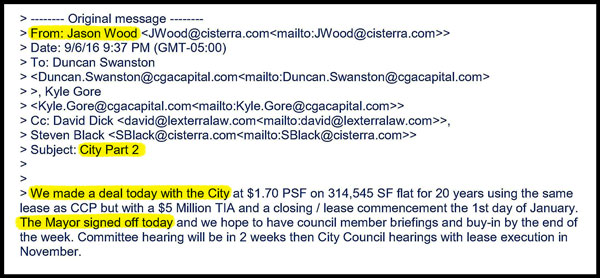
According to the rate, square footage, and term of the lease outlined in Woods email, the partners quickly confirmed that the total amount of payments Faulconer had agreed to totaled $128,334,360.00 over the term of the agreement. Using their known financing interest costs, the group calculated their upfront net profit from financing the deal at nearly $20 million after deducting the building’s $74.4 million sale price.
Woods’s email referenced Civic Center Plaza, a nearly identical lease deal the City signed with Cisterra in 2014 that also saw the City enter into a 20-year lease-to-own agreement to acquire another building near City Hall which houses the City Attorney’s office. That lease was signed at a time when the City could not borrow money in the financial markets due to a pending lawsuit. That dispute had already been resolved by the time the 101 Ash lease was proposed, eliminating the need to use the more expensive lease option.
The day after the meeting in Faulconer’s office, Deputy COO Ron Villa emailed other staff working on the deal to inform them that they would be pursuing a lease, not a purchase. The staff had been working for months on a deal to purchase the building, even conducting appraisals on the property’s market value. Villa had attended the meeting in Faulconer’s office the previous day, but did not share with staff that the Mayor had made the decision to use a lease instead of a purchase.
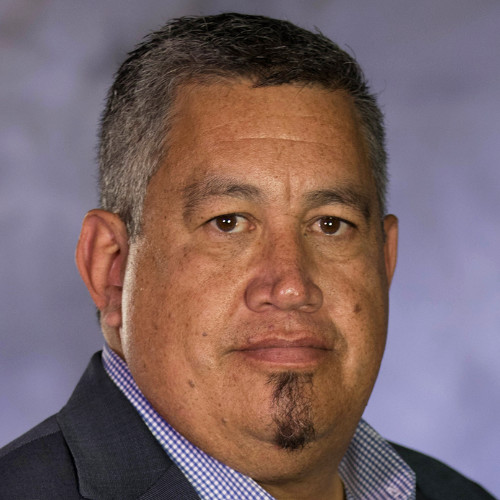
Ron Villa 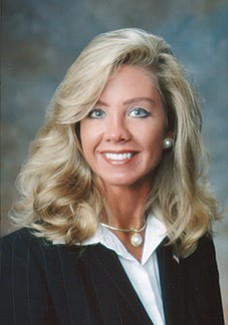
Cybele Thompson
Villa and Cybele Thompson, the City’s Director of Real Estate Assets, who also attended the Mayor’s office meeting, then held briefings with City Councilmembers and staff leading up to a committee hearing on September 21, about three weeks after the meeting. During the committee hearing, Villa and Thompson presented the lease as the only option available, but did not disclose that Faulconer had directed them down that more expensive path.
Councilman Davis Alvarez questioned Villa and Thompson on why the City would use a more expensive lease, but the two senior staffers told the Councilmembers that there were legal issues with pursuing a purchase, something that had not been discussed as an issue before the meeting in the Mayor’s office.
The City Council eventually voted to authorize the lease deal and associated funding on October 14, 2016, and the final Council action for its required second reading was on November 14, 2016, consistent with the timeline set out in Wood’s email.
MEDIA QUESTIONS ABOUT LEASE
Although the meeting had taken place four years earlier, the importance of the Mayor’s decision to use a lease instead of a purchase only came under scrutiny after the City evacuated the building in January 2020 due to loose asbestos material in the air. The building has been vacant ever since.
In September 2020, months after the building had been evacuated, media reports began to question the origins of the lease deal.
Several sources with direct knowledge of that meeting provided details which led La Prensa San Diego to seek comment from Faulconer’s office before publishing a story about the meeting.
Specifically, the sources recounted that Faulconer directed senior staff to only pursue a lease and specifically told them that he did not want to be seen as paying “Papa” Doug Manchester directly.
Manchester was one of Faulconer’s biggest campaign donors and one of the two owners of the 101 Ash building at the time. The sources included details that CFO Lewis confronted Faulconer about the additional costs but that the Mayor dismissed those warnings.
La Prensa San Diego’s Publisher, Art Castañares, emailed Gustafson with questions about the claims made by the sources.
“Did Mayor Kevin Faulconer say to staff that it would be politically damaging for him to be seen as paying Doug Manchester directly, and instead, instructed staff to only pursue a lease-to-own agreement? Did staff alert Mayor Kevin Faulconer to the fact that the lease-to-own agreement would cost taxpayers millions of dollars more than a direct purchase, and did the Mayor continued to direct staff to pursue the lease deal despite the additional costs?” Castañares’ email read.
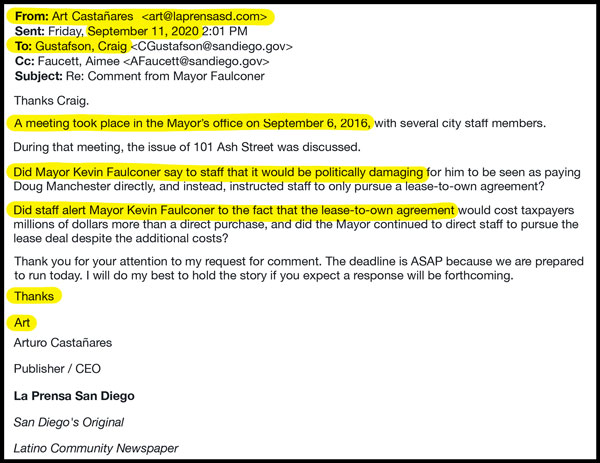
In response to the request for comment, provided a statement which he said could “be attributed to me” but failed to confirm or deny the specific allegation related to the Mayor directing staff to pursue a more expensive lease instead of a purchase.
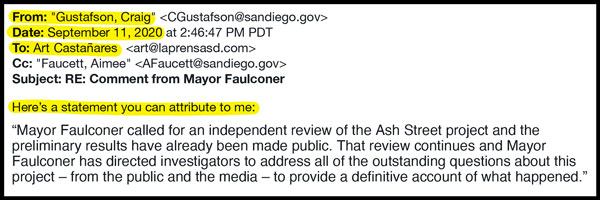
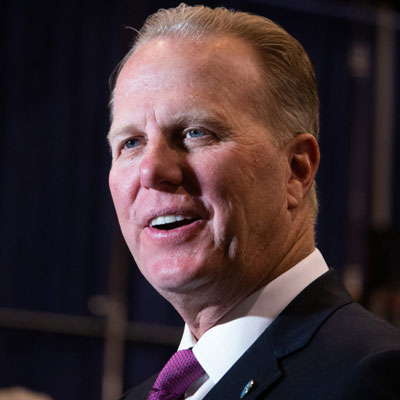
Kevin Faulconer 
Craig Gustafson
La Prensa San Diego published its story on September 11, 2020 reporting the details of the meeting according to “multiple sources” familiar with the meeting. No other media outlet had previously reported on the meeting or that Faulconer directed staff to pursue a lease.
The story reported that the five most senior staff of the City attended the meeting, including Chief Operating Officer Scott Chadwick, Deputy COO Stacey LoMedico, Assistance COO Ron Villa, CFO Lewis, Director of Real Estate Assets Cybele Thompson, as well as Faulconer’s Chief of Staff Stephen Puetz.
The sources’ identities were known and verified by La Prensa San Diego, but were not disclosed in the story to protect them from workplace retaliation.
After that story was published, Gustafson emailed another response to Castañares, claiming the premise of the article was “inaccurate” and that the claims about Faulconer’s actions were “false”.
“The premise of your articles is inaccurate and the allegations about the Mayor are false. After what just happened with NBC 7’s inaccurate reporting with fabricated information on this same topic, the public should be dubious about articles that have a clear political agenda and rely solely on anonymous sources that may or may not have been properly and thoroughly vetted. I have little confidence that you have exercised that level of care in your ‘reporting’ since it reads like a gossip column,” Gustafson wrote.
Gustafson complained that the story was “completely based on anonymous sources”, although the sources were known but unnamed.
Gustafson’s assertions that the story was inaccurate, however, were themselves based on anonymous sources because he was not in the September 6, 2016 meeting; he, therefore, provided information relayed to him by either Faulconer, Chief of Staff Stephen Puetz, or other mayoral staffers who were in the meeting, but could not attest to the accuracy of his own statement.
But Gustafson went further than the denials, and attacked Castañares’ credibility and motives.
“You are not a legitimate journalist but rather a longtime political operative in South Bay. Your motives and journalistic integrity are questionable at best,” Gustafson claimed.
Castañares, who worked for 13 years as staff in the California State Legislature and later served as a political consultant on several high-profile election campaigns, became the Publisher of La Prensa San Diego in 2015. He has since written hundreds of news articles and editorial pieces on a variety topics, including 101 Ash St.
Last year, Castañares won the prestigious Ruben Salazar Award for Excellence in Journalism presented by the California Chicano Media Association, the oldest Hispanic journalism group in the country, for an editorial piece he wrote about the death of Angel Hernandez at the hands of MTS security guards in 2019.
On the same day Gustafson launched personal attacks against Castañares, he also responded to questions about the September 6, 2016 meeting sent from another local media outlet, Voice of San Diego. 10 days after La Prensa’s story detailing the meeting in the Mayor’s office, VoSD reporter Lisa Halverstadt asked Gustafson about the specific details in the story.
Halverstadt referenced La Prensa San Diego’s story as the basis of her questions, possibly explaining why Gustafson resorted to personal attacks against Castañares after another news outlet quoted his unflattering story about Faulconer.
“La Prensa recently reported on a Sept. 6, 2016 meeting where the mayor allegedly told top city officials and others gathered at a meeting about next steps regarding the purchase/lease of 101 Ash Street that the city would need to proceed with a lease to own arrangement because it would be “politically naive” and problematic to pursue a transaction/sale directly between the city and Doug Manchester, who had a 49 percent ownership stake in the building. Can the mayor recount his recollection of the meeting?” Halverstadt asked.
Halverstadt specifically asked about the CFO’s warning to Faulconer that the lease would cost taxpayers millions of dollars more than a purchase.
“Does the mayor recall hearing that a lease-to-own arrangement would result in approximately $16 million less in savings for the city? What about $17 million or a similar amount?” Halverstadt asked Gustafson in the same email.
Gustafson responded by focusing on expected savings compared to renting other office spaces, but ignored that Lewis cautioned Faulconer that the lease would cost the City more than a purchase.
“The Mayor was told that the lease-to-own option would result in tens of millions of dollars in savings with the elimination of costly office leases elsewhere,” Gustafson wrote back.
Given the sworn testimony by Lewis and the emails from Cisterra, it now appears that Gustafson’s accusations, denials, and deflections were inaccurate and false.
Faulconer and his then-Chief of Staff Stephen Puetz both testified in depositions recently, but neither one recalled exactly what Lewis reported warned him during the pivotal meeting, and both denied Faulconer specifically mentioned Manchester as a reason to avoid buying the building directly.
Other senior officials who were also in the meeting have not yet been deposed in the lawsuits.
Castañares emailed Gustafson this week for an opportunity to comment on Lewis’ testimony and emails that directly contradict his statements in September 2020. Gustafson did not respond.
Before going to work for Faulconer in 2014, Gustafson was a reporter for the San Diego Union-Tribune for 10 years. He worked in Faulconer’s office until the end of his mayoral term in December 2020 when Todd Gloria became Mayor.
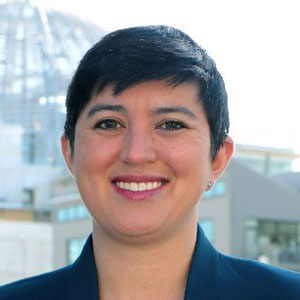
Soon after entering the Mayor’s office, Gloria appointed Jen Lebron as his spokesperson. Lebron had worked as a digital media manager for the City’s IT department before joining Gloria’s staff.
Gustafson transitioned from Faulconer’s office to become a digital services coordinator in the City’s IT department, effectively replacing Lebron who essentially replaced him.
Lebron, also a former SDUT reporter, is married to Gustafson. They appear to have switch jobs between spokespersons for the Mayor and the City’s IT department.
Last year, Lebron left Gloria’s office and is now the External Affairs and Outreach Coordinator for the City’s Public Utilities Department.
GUSTAFSON’S INVOLVEMENT IN DECEPTIVE 101 ASH LETTERS
Gustafson has also been tied to another aspect of the 101 Ash Street debacle for his role in preparing two fake letters given to contractors just weeks before City employees were moved into the building in December 2019. Two sources claim Gustafson prepared the letters within Faulconer’s office.
Two letters, written in the names of West Coast Construction and CBRE, were prepared by Faulconer’s office and delivered to the contractors by James Nagelvoort, the City’s Director of Public Works, and by Cybele Thompson, the City’s Director of Real Estate Assets, respectively. The two contractors were asked to submit those prewritten letters back to the City as if they had written the letters themselves.
The nearly identical letters were meant to convey that the building was safe to occupy even though senior staff and the contractors knew that the building had not passed final safety inspections required for an occupancy certificate. Fire life safety systems were still inoperative when the letters were sent.
Nagelvoort emailed one letter to David Davey, President of West Coast Contraction, the general contractor managing the renovations to the building from 2017 to 2020. Nagelvoort sent the letter addressed from Davey back to himself. Nagelvoort’s email suggests that they had discussed the letter before.
Davey later submitted the letter to the City on his company’s letterhead.
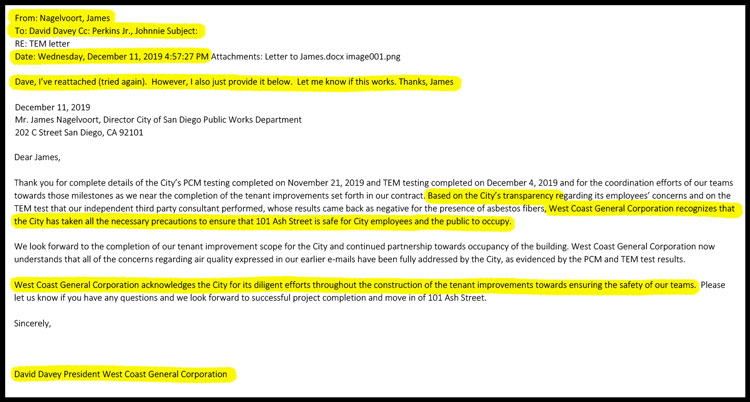
City staff then used West Coast’s final version of the letter during a City Council meeting as proof to claim that the building was safe to occupy, without admitting that the Mayor’s office had written the misleading letter in the first place. The letter was also sent to the San Diego Union-Tribune in response to questions about the condition of the building.
Nagelvoort’s letter, however, was sent only five days after Davey had emailed Nagelvoort and other senior City officials expressing his concerns that critical systems were still not working and that the City had not allocated funds necessary to repair or replace those systems. Davey wrote that he knew the City was “under significant political pressure to meet what are noncontract-imposed milestones.”
Sources who worked on the project say Mayor Faulconer’s office was pushing to move employees into the building regardless of the true condition of critical fire life safety systems.


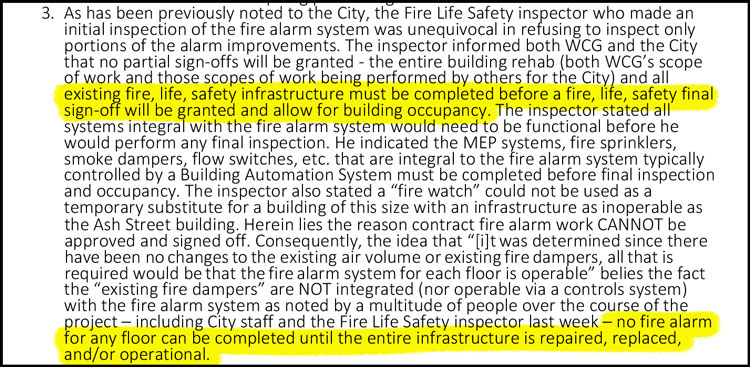
The second letter was handed to John Frager, Senior Managing Partner of CBRE, by Thompson, the City’s Director of Real Estate Assets. Frager later edited the letter to be to Nagelvoort instead of Thompson, but still included the critical sentence that “the City has taken all precautions to ensure that 101 Ast Street is safe for employees and the public to occupy.”

A former executive, Juan E. Rose, III, who reported directly to Frager, confirms that Frager received the letter in person from Thompson. Rose maintains that he advised Frager not to sign it because CBRE had not yet made a determination that the building was ready to be occupied. Rose later left CBRE after being removed from working directly on 101 Ash project.
This week, La Prensa San Diego emailed Gustafson for an opportunity to comment on the allegations that he prepared the two letters which falsely claimed the building was safe to occupy. Gustafson did not respond.
Emails released through California Public Records Act requests reveal that Gustafson was asked about the Nagelvoort letter back in September 2020 by NBC reporter Dorian Hargrove. Hargrove was the first reporter to question the status of the 101 Ash building when it was filled with employees in December 2019.
Hargrove asked Gustafson to comment on the City’s creation of a letter in the name of the general contractor and then using it to bolster their own arguments that the building was safe.
Gustafson never responded to Hargrove’s request for comment.
FAULCONER’S FATEFUL DECISION
Under the City’s strong-mayor form of government, the Mayor serves as the CEO of the City and directs major policy decisions which then have to be approved by the Council.
In this case, it was Faulconer who decided to pursue a lease even when faced with opposition from the City’s CFO, the most qualified person in the City on financial decisions.
Mary Lewis, the City’s CFO from 2008 to 2017, oversaw the City’s $3 billion annual budget and managed the City’s Comptroller, Treasurer, Debt Management, Risk Management, and Financial Management departments. She had previous served as the CFO of the City’s Employee Retirement System which manages over $6.5 billion in pension investments.
When Lewis retired in October 2017, Mayor Faulconer and the City Council approved a proclamation declaring October 7 as Mary Lewis Day in the City of San Diego.
Last year, Lewis was interviewed during an investigation conducted by the City Auditor, where she testified that she did not support using a more expensive lease when the City could have purchased the building directly using less expensive public bond financing. None of the senior staff members in the meeting advised the Mayor to pursue a lease instead of a purchase.
Emails and sworn testimony coming to light through three lawsuits related to 101 Ash St have revealed information that was not previously public.
The timing of Faulconer’s directive to pursue a lease instead of a purchase now fits into the narrative pushed by the sellers, landlord, and the City’s pro bono real estate broker, Jason Hughes.
Faulconer dismissed the advice and caution of the City’s experienced CFO and, instead, decided to use a lease which required less disclose of the financial details of the deal and allowed the sellers, landlord, and broker to make millions of dollars more than they otherwise would have had the City purchased the building directly.
Last year, after months of dodging media questions, Hughes admitted that he received $4.41 million in profit sharing from Cisterra’s financing of the 101 Ash building lease, in addition to cover $5 million he received from Cisterra after closing the CCP lease in 2014.
Hughes had served as an unpaid advisor to the City since being appointed by then-Mayor Bob Filner in 2013, and continued when Todd Gloria served as interim Mayor, then during the entire seven years of Faulconer’s time in the Mayors office.
The City is now suing to invalidate the 101 Ash lease because of Hughes’ conflict-of-interest in helping to negotiate and advance the lease in which he had an economic interest.
City Attorney Mara Elliott claims Hughes violated California Government Code 1090, a series of laws prohibiting self-dealing in public contracts. Elliott charges that the lease is void because of Hughes’ transgressions.
CITY ATTORNEY WATCHDOG FAILED TO ACT
But, under the City’s Charter, the City Attorney is the only person authorized to bind the City in a contract, but also the one who must ensure that the disclosure provisions of the Charter are met before approving a contract.
At the time the 101 Ash was signed, Charter Section 225 required a “full and complete disclosure of the name and identity of any and all persons directly or indirectly involved in the application or proposed transaction and the precise nature of all interests of all persons”.
Elliott, who had been elected City Attorney five weeks before the final lease was approved by her office, failed to confirm that all of the people who benefited from the lease were properly disclosed.
Her office approved the lease on December 19, 2016.
Had Elliott enforced the provisions of Section 225, Hughes’ conflict-of-interest would have been revealed and the lease would not have been signed at the time. Hughes and Cisterra maintain that the City Attorney’s office never asked them to disclose information as required under Section 225.
Elliott is now suing to invalidate the lease which she never should have signed without conducting the full legal due diligence required by the Chafter.
The City is now engaged in behind-the-scenes negotiations to settle the three pending lawsuits related to the building lease.
Just this week, emails were leaked showing that Councilmembers have been meeting or speaking with a mediator working on a potential settlement.
Two weeks ago, the City Council held a four-hour closed session meeting behind closed doors to discuss a potential settlement. Sources say that the City’s lead outside lawyer, Dick Semerdjian, has floated a plan to include requiring Hughes to return the money he made in the deals in exchange for avoiding being charged criminally for his conflict of interest.
Sources also say that proposal discussed in closed session was offered by the City’s current Chief Operating Officer, Jay Goldstone, who is scheduled to retire shortly.
Last week, La Prensa San Diego Publisher Art Castañares, asked Mayor Gloria during a press conference if he would confirm or deny that the COO made the proposed settlement.
Gloria said he could not comment on closed session, but did not deny that the proposal was offered by Goldstone who reports directly to Gloria.
The San Diego Union-Tribune later reported that Goldstone had reached out to Cisterra Development’s lobbyist, Chris Wahl, to set up a call with Cisterra’s principal partner, Steven Black on the day before the closed session meeting occurred.
The Council did not report any action taken during the closes session meeting.
The three lawsuits continue to move forward with depositions and discovery requests.


 Alberto Garcia
Alberto Garcia





